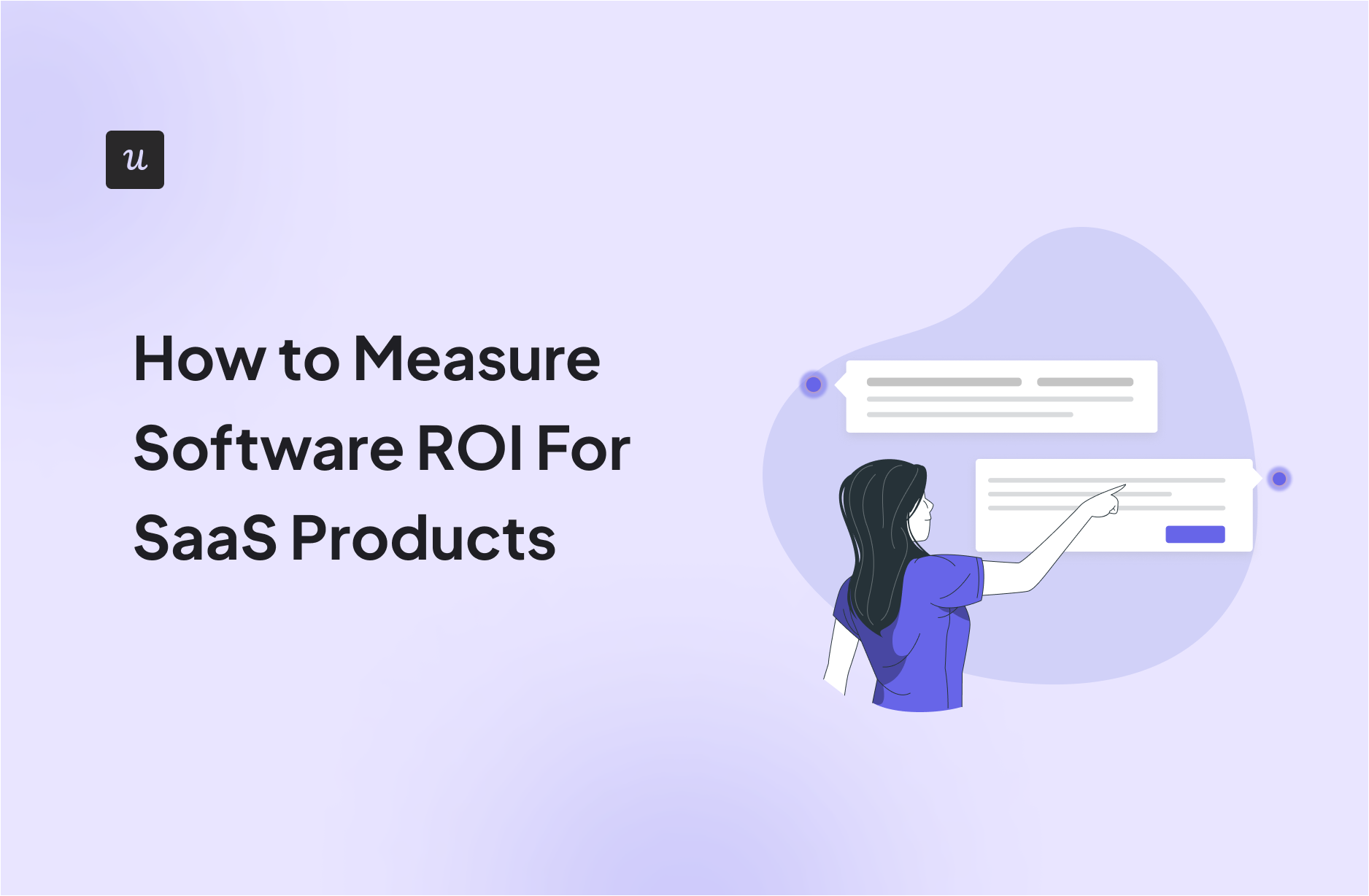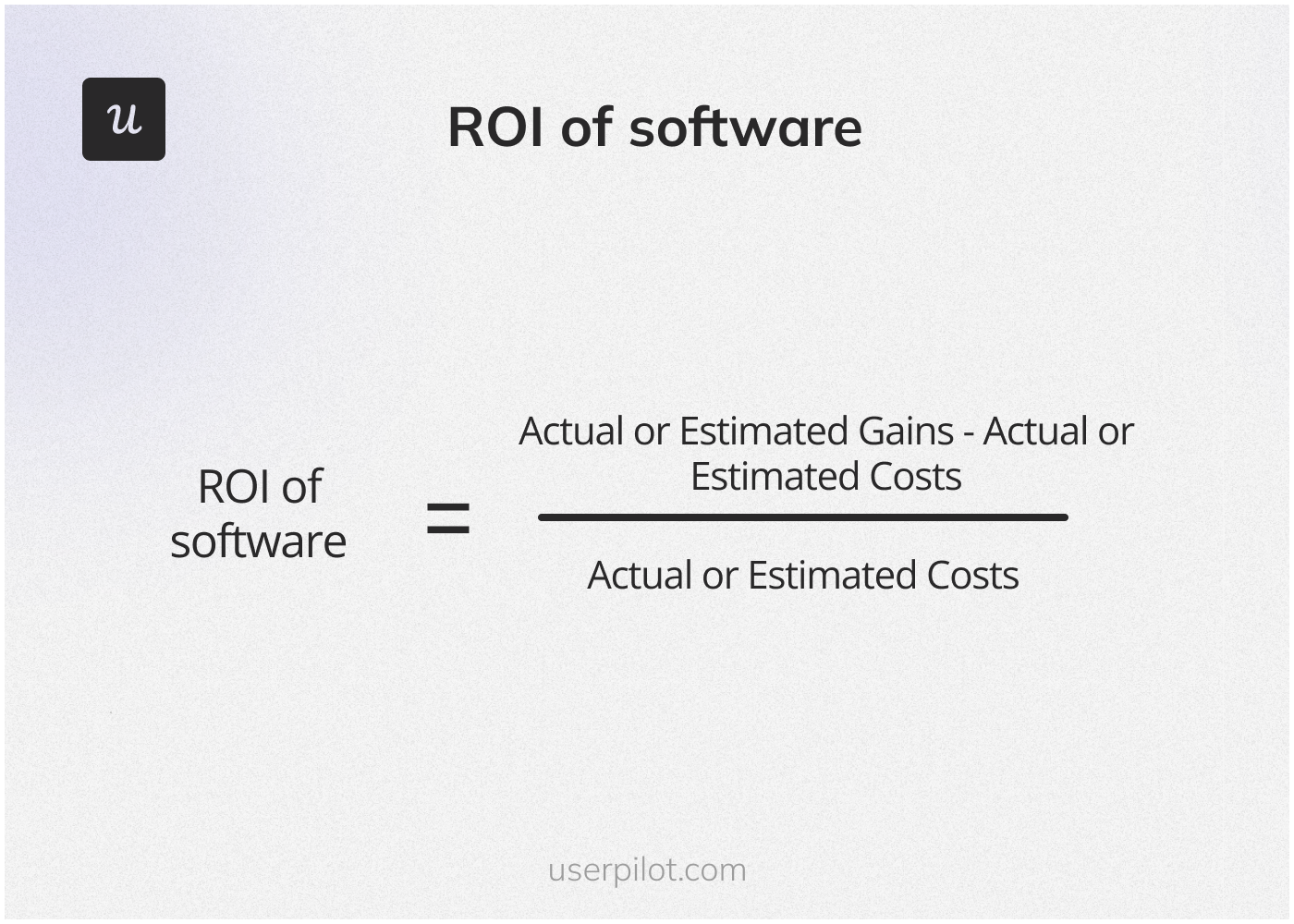
Ever bought a SaaS tool and wondered if it’s truly worth the money? With so many tools in your tech stack, it’s easy to lose track of what’s delivering value and what’s not. That’s why keeping a pulse on software ROI metrics is important.
In this article, we’ll cover everything related to software ROI, from identifying the right metrics to tracking your progress and making informed decisions that fuel business growth.
Try Userpilot Now
See Why 1,000+ Teams Choose Userpilot

What is the ROI of software?
Software ROI, or Return on Investment, is the financial and business benefits of implementing an application.
We distinguish between hard ROI and soft ROI.
Hard ROI represents concrete, quantifiable, and easily measurable financial returns that result from an investment.
Soft ROI, on the other hand, is the qualitative and less tangible benefits of an investment.
These can be challenging to quantify in monetary terms and include improvements in internal business processes leading to increased productivity or improved customer service, to name just a couple.
Why is Software ROI calculation important?
Calculating software ROI is vital for making informed decisions about technology investments and allocating resources adequately.
First, it can help organizations justify the costs of software implementation to secure the buy-in of the key decision-makers.
Next, it assists in deciding between building software in-house and licensing expensive software solutions from 3rd parties. And if choosing a 3rd party tool, organizations can use it to select the most competitive one.
Finally, software ROI is used to assess the performance of new software projects.
Calculating ROI for different software projects
How you calculate ROI depends on whether you’re developing the software in-house or buying a SaaS solution. In each case, there are multiple factors to consider.
Custom software development in-house
When calculating ROI for software built in-house, consider the following:
- Product development costs – including salaries for software developers, UX designers, product managers, and project managers, as well as the cost of any necessary hardware, software tools, and infrastructure.
- Implementation costs.
- Maintenance costs – the ongoing expenses for bug fixes, software updates, and system improvements.
- Staff onboarding and training costs.
- Cost of missed opportunities – ones you could take advantage of if you had the software in place.
- Estimated returns – the projected benefits or gains generated by the software.
- Period of time – how long the software will keep generating returns.
Accurately assessing estimated returns is not easy as there are multiple ways in which software can benefit the organization.
For example, business process software projects can have lots of indirect returns that are difficult to pinpoint, like increased staff motivation.
Investing in a third-party SaaS application
Some of the factors to consider when investing in a 3rd party SaaS application are the same as when building it in-house. For example, you still need to assess the estimated returns, implementation, and staff onboarding and training costs.
Overall, however, the process is easier because you take away the most complex calculations, that is, the development and maintenance costs. SaaS vendors handle these aspects for you – you just pay the subscription fees.
How to calculate ROI for Software
Once you determine what factors to consider, a basic ROI calculation is fairly straightforward.
Here’s a generic formula that you can use for different software types, both built-in-house and SaaS.
Software ROI = (Actual or Estimated Gains – Actual or Estimated Costs)/Actual or Estimated Costs

What is a good ROI percentage for software projects?
This is a how-long-is-a-piece-of-string kind of question. That’s because the numbers will vary from industry to industry or product to product.
However, there are some figures to consider:
- According to iSixSigma, a decent ROI for IT projects is 5-10%.
- For ClearPoint Strategy, a good ROI sits at around 20%.
KPIs to measure the ROI for new software system
What KPIs and metrics should you use to measure the return on investment for new IT solutions? Let’s have a look.
Cost of ownership
The cost of ownership, or the Total Cost of Ownership (TCO), is a crucial factor in measuring software ROI.
It’s made up of all expenses associated with acquiring, implementing, using, and maintaining a software solution throughout its lifecycle.
TCO includes not only the initial purchase or development costs but also ongoing expenses like licensing, support, training, maintenance, and upgrades.
Calculating TCO is essential in software ROI measurement because it provides a comprehensive view of the true financial impact of the software.
Implementation cost
Implementation costs include all the expenses related to integrating the software into existing systems.
For example, it could include data migration or potential downtime during the transition when you’re not able to perform normal operations.
Time to value
Time to value is the time needed by employees to realize the software’s value.
The more complex the product and the more training it requires, the longer the TTV.
One factor that can affect time to value is the quality of the onboarding and training resources. If done well, they can flatten the learning curve massively.
Risks associated
Risks associated can be interpreted in two ways.
On the one hand, it could be all the risks related to software development and implementation, like project delays, budget overruns, technology changes, or security vulnerabilities.
On the other hand, this could also be the value of risks that the new software allows you to mitigate more effectively. For example, a new solution can make data storage safer, and protect the company from costly and damaging breaches.
Return on time saved
Return on time saved is a measure that focuses on the efficiency gains achieved through a software solution.
It quantifies the value of the time saved by employees or users, for example, thanks to automation of tasks, streamlined processes, or faster access to information.
The metric can be a valuable KPI in assessing the impact of software, especially in terms of workforce productivity and cost reduction.
Tips to implement during software ROI calculation
Because of the numerous variables, calculating the ROI for software tools may be tricky.
How can you calculate it accurately?
Here are a few tips.
Determine pessimistic and optimistic values for software expenses and benefits
When it comes to IT projects, things rarely go to plan. Such projects are notorious for running over the budget and behind schedule. These factors will reduce the return on your investment.
For this reason, calculate your ROI based on 2 values. Look at the most optimistic and pessimistic costs.
The same applies to benefits. Apart from the best-case scenario, look also at more pessimistic estimates.
While it’s important to be positive, it would be really naive to think that you’re going to realize 100% of the possible benefits, not immediately anyway.
Decide on the timeframe for ROI measurement
Speaking of which…it’s vital to consider carefully the timeframe for your ROI calculations.
Why so?
First, different software investments may have different payback periods. For example, a more complete solution that requires lengthy implementation and staff training won’t generate any returns in the first few months.
Even after that, your new software won’t deliver 100% of its potential value right off the bat. More likely than not, it will be a gradual process and the ROI will start increasing over time.
On the other hand, be aware that your solution may also stop generating returns after a period of time, for example as a result of obsolescence.
What’s more, consider both short-term and long-term gains of implementing the software.
Short-term benefits could be improved efficiency and lower staff workloads, while long-term gains could be higher staff retention, greater customer satisfaction, and higher profits.
Calculate both anticipated and actual ROI
At the beginning of a software project, it is incredibly difficult to make realistic estimates as to the duration of the project and its cost. Even if you’re choosing a SaaS solution, the actual time needed to implement it may vary from company to company.
The same applies to the benefits or gains. Based on case studies of similar projects at similar companies, you may be able to roughly predict what sort of return you’re looking at, but it won’t be accurate.
However, as more data becomes available during the project, use the figures to recalculate the estimated costs. Do the same with the returns once the software is implemented.
By comparing the anticipated and actual ROI, you will be able to better estimate the ROI for future software projects.
Example of software ROI for a user onboarding solution
When choosing a user onboarding solution, you have two options: either build your custom technology or use an existing SaaS product like Userpilot.
If you go with the first option, you can either build it in-house or outsource the process to a specialized software provider.
Let’s start with the in-house solution.
The first question to answer here is whether you have the technical expertise and bandwidth to create the solution.
If the answer is yes, you should also have the know-how to estimate the project duration and cost. This will include the costs of project management, development, quality assurance, software, and infrastructure needed to support it (like cloud storage).
If the answer is no, factor in the costs of hiring the right product team. That’s the actual salaries as well as the costs involved in their recruitment.
If you decide to outsource the product development process to an external provider, the custom solution is most likely going to be more expensive than building in-house but will require less level of effort.
You will also need to account for the effort involved in researching providers, negotiating the deals, and overseeing the process.
As both solutions won’t be available immediately, consider also the cost of missed business opportunities while waiting for the software, like losing your competitive advantage in the market.
With existing software like Userpilot, you can achieve ROI faster because of the time saved on development. A SaaS product also comes with lower upfront and maintenance costs.
At the same time, SaaS onboarding tools still allow teams to create native-like onboarding experiences, so customization isn’t a problem.

Conclusion
Software ROI compares the benefits of implementing a software solution against its costs. This is essential to build a sound business case for buying or developing a tool and helps the team track its performance once implemented.
To find out how Userpilot can help you maximize your returns on investing in user onboarding, book the demo!








